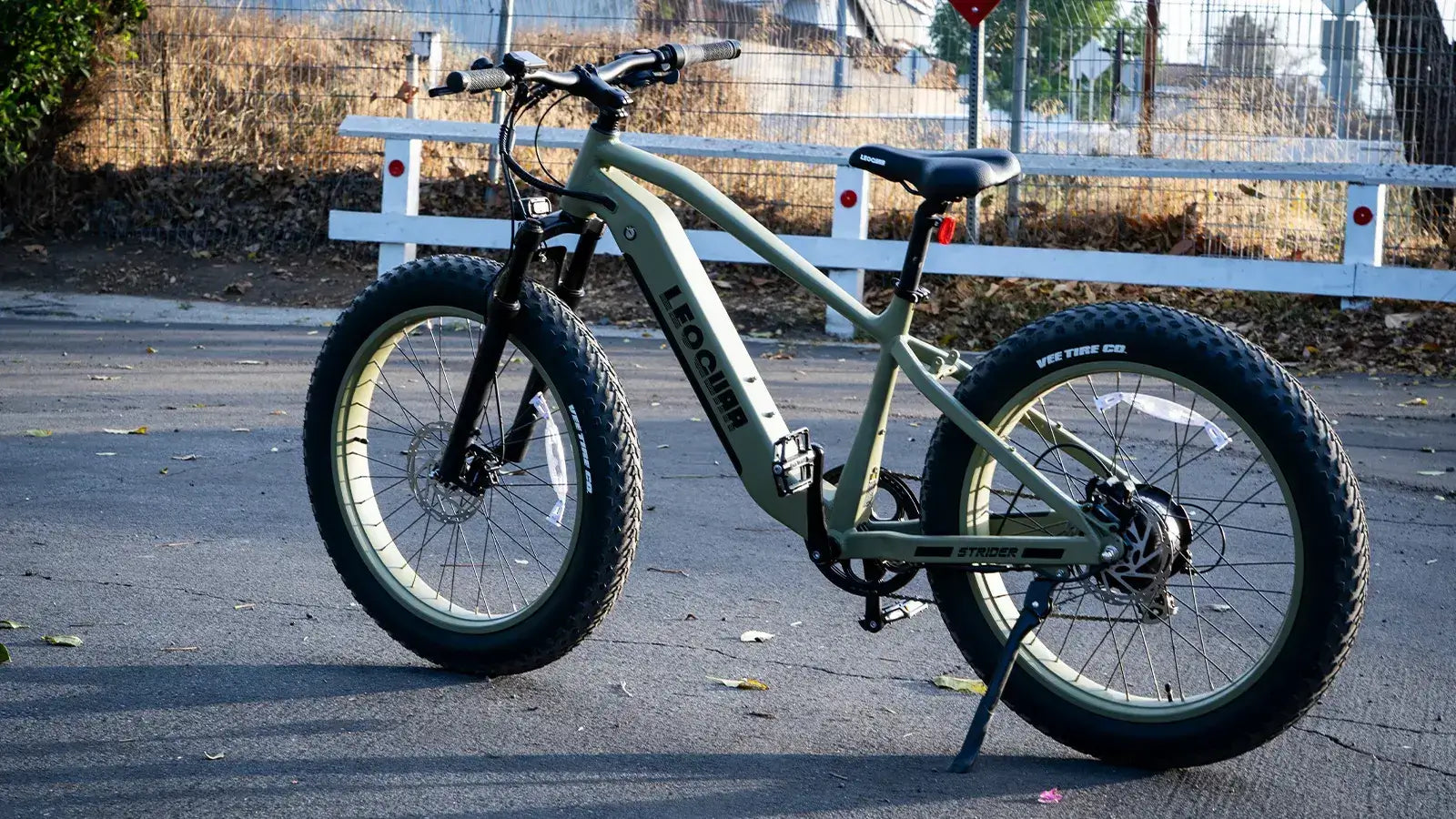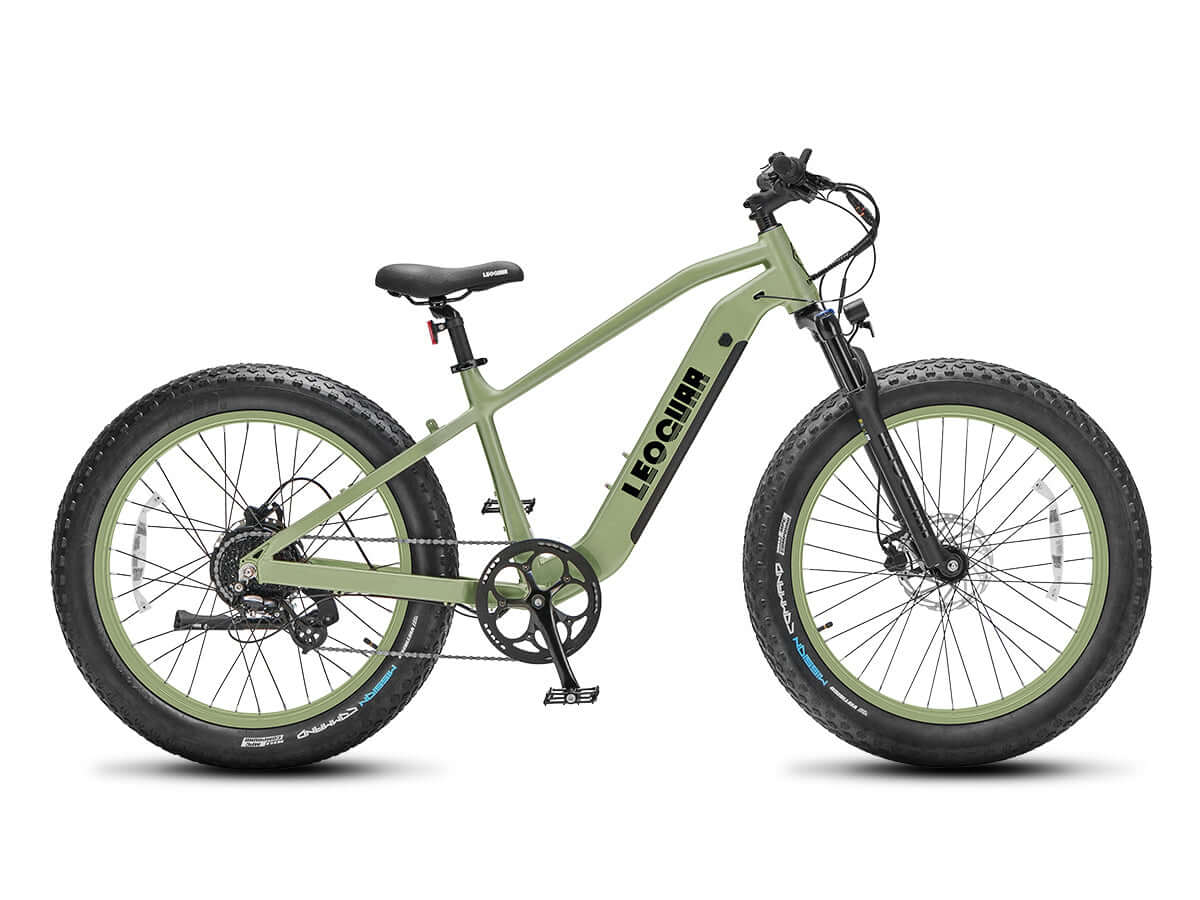
Electric Fat Tire Mountain Bikes vs All Terrain: Key Differences
The Right Tool for the Trail
Finding the right e-bike can be tough. Terms like "fat tire" and "all-terrain" are often used to mean the same thing, but they're actually different. The main difference is simple: fat tire e-bikes are built for specific jobs. They have huge tires that are 4 inches wide or bigger, made for tough conditions like sand and snow. All-terrain electric bikes are more flexible and can handle many different surfaces, from city streets to light trails.
Many modern bikes mix these features together. This makes it important to compare them carefully before choosing the right bike for you. Whether you're looking at tough electric fat tire mountain bikes or a flexible all terrain electric bike, you need to understand how they're designed differently. As noted in many expert-tested reviews of various e-bike categories, the best choice always depends on what the rider needs and where they plan to ride.
The Fat Tire Specialist
A real fat tire electric bike has one main feature: huge tires. As a rule, this is a defining characteristic of fat bikes: the tires are 4.0 inches wide or bigger. This design isn't just for looks - it's all about function. The huge surface area lets the tire "float" over soft, unstable surfaces like deep sand, fresh snow, and thick mud where a regular bike tire would sink and get stuck.
This works because you can run very low tire pressure. While a regular mountain bike might use 25-35 PSI, a fat bike tire can run at 5-15 PSI for off-road riding. This lets the tire bend and create a huge contact area, giving maximum grip and flotation.
Main strengths include:
- Great stability on loose and unpredictable ground.
- Natural shock absorption from the high air volume, smoothing out rough terrain.
- Strong grip that builds confidence in extreme weather and on soft surfaces.
The Versatile All-Rounder
The term "all-terrain" is less a strict category and more a way to describe what the bike can do. It describes an e-bike built to be good at many things, handling a wide variety of surfaces well without being the best at one extreme condition. Think of it as the SUV of the e-bike world - comfortable on the road but ready for a trip onto a gravel path or forest trail.
These bikes balance features for a do-everything approach. You'll often find them set up as well-equipped, all-terrain electric commuters, mixing daily use with fun rides.
Common features include:
- Medium-wide tires, usually between 2.2 and 3.0 inches, with a flexible tread pattern for grip on dirt and smooth rolling on pavement.
- Front suspension forks are common to absorb bumps, with some models offering full suspension for greater comfort and control.
- Balanced frame shape that gives an upright, comfortable position for commuting but is still capable enough for light trail riding.
- Practical add-ons like built-in mounts for fenders and cargo racks are often standard.
Head-to-Head Comparison
To make the choice clearer, a direct comparison helps show the main trade-offs. This table breaks down the key differences quickly, letting you see which bike matches your needs.
| Feature | Fat Tire Electric Bike | All-Terrain Electric Bike |
|---|---|---|
| Tire Width | 4.0"+ (Specialist) | 2.2" - 3.0" (Versatile) |
| Primary Strength | Extreme conditions (sand, snow, mud) | Mixed-surface riding (pavement, gravel, light trails) |
| Traction | Unmatched on soft surfaces | Excellent on firm to moderately loose surfaces |
| Handling & Agility | Slower, more deliberate, and stable | More nimble and responsive on firm ground |
| On-Pavement Efficiency | Lower due to high rolling resistance | Higher due to less rolling resistance |
| Weight | Generally heavier | Typically lighter |
| Typical Rider | The specialist adventurer or all-weather rider | The versatile explorer or rugged commuter |
Beyond the Buzzwords
Understanding the spec sheet is one thing; understanding the why behind it is what makes you a smart buyer. The terms "fat tire" and "all-terrain" are marketing labels that sit on a range. Let's look past the buzzwords and study the main design choices.
Tire Width and Pressure
This is the most important difference. A fat tire's low pressure (5-15 PSI) and huge width create a large, flexible contact area. This is the key to its "float" on sand and snow. However, on pavement, that same large contact area creates a lot of rolling resistance, making the bike feel slower and need more energy from both you and the motor. An all-terrain tire (25-40 PSI) offers a middle ground. It's wide enough for stability on gravel and dirt, but its higher pressure and smaller contact area reduce rolling resistance for more efficient riding on pavement.
Suspension and Frame Geometry
At first, fat bikes used their tires as the main suspension. The huge volume of air does a great job of absorbing small bumps. However, as the category grew, many electric fat tire mountain bikes now include front or even full suspension. This adds a lot of control and comfort for tackling real mountain trails with roots and rocks, not just soft surfaces. All-terrain bikes almost always have at least a front suspension fork, paired with frame shape that focuses on a balance of comfort and control - often more upright than a dedicated mountain bike but more aggressive than a simple cruiser.
Motor and Drivetrain
The extra weight and rolling resistance of fat tires need more power. Because of this, fat tire e-bikes often have powerful hub or mid-drive motors with high torque ratings to get them moving and keep speed, especially on soft ground. An all terrain electric bike, being lighter and more efficient, can use a wider range of motors. Some focus on a quiet, natural-feeling pedal assist for long-distance efficiency, while others use powerful motors to emphasize their "go anywhere" ability.
Choosing Your Perfect Ride
The best bike is the one that fits how you actually ride. Be honest about where you'll spend 90% of your time.
The All-Weather Adventurer
Do you live where it snows for months? Do your dream rides involve sandy beaches or muddy backcountry trails? If you need a bike that won't be stopped by extreme surfaces, the choice is clear. The flotation and unmatched grip of a fat tire electric bike are what you need. It is the best tool for soft-surface exploration.
The Versatile Explorer
Is your ideal ride a mix of everything? You commute on bike paths during the week, explore gravel farm roads on Saturday, and ride into light forest trails on Sunday. You need a bike that can do it all without problems. An all-terrain electric bike offers the perfect balance of on-road efficiency and off-road ability for the rider who values variety.
The Rugged Urban Commuter
Do you navigate a city full of potholes, cracked pavement, and the occasional unpaved shortcut? You put comfort and stability over pure speed. An all-terrain bike is a great choice, smoothing out rough city streets. Even a fat tire e-bike with smoother, street-oriented tires can serve as the ultimate comfort cruiser, providing a soft ride and rock-solid stability.

The Rise of Hybrids
The market has responded to riders who want it all, leading to the rise of the "all-terrain fat bike." These hybrids try to merge the two categories. Usually, they have 4.0-inch fat tires but are also equipped with features common to all-terrain models, such as full suspension, built-in racks, and fenders.
These bikes offer the supreme comfort and go-anywhere visual appeal of fat tires combined with the practical features of a daily driver. The upside is unmatched cushioning and the confidence to roll over nearly anything. The downside is weight and efficiency. They are often the heaviest e-bikes on the market and can feel slow on pavement compared to a true all-terrain model. They represent the ultimate "comfort is king" philosophy but sacrifice the agility and efficiency of their more specialized cousins.
Final Expert Takeaway
The choice between an electric fat tire mountain bike and an all terrain electric bike comes down to a simple question: are you buying a specialist or a generalist?
Fat tire e-bikes are specialists for the softest, most challenging surfaces. All-terrain e-bikes are generalists for the rider who wants to do a little bit of everything. The industry is full of hybrids that blur these lines, but the main principles of tire width, pressure, and design intent remain. There is no single "best" e-bike, only the best e-bike for you. Check your real needs, understand the trade-offs in handling and efficiency, and if possible, test ride both types. By choosing a bike that matches your main riding style, you ensure every journey is a great one.
Frequently Asked Questions
Q: Can I use a fat tire e-bike for daily commuting on city streets?
A: Yes, you can use a fat tire e-bike for commuting, but it may not be the most efficient choice. Fat tires create more rolling resistance on pavement, which means the bike will feel slower and use more battery power compared to an all-terrain bike. However, if comfort is your top priority and you don't mind the trade-off in speed, fat tires provide excellent cushioning over potholes and rough city streets.
Q: What's the main advantage of all-terrain electric bikes over fat tire bikes?
A: The main advantage is versatility and efficiency. All-terrain electric bikes handle a wide variety of surfaces well while being more efficient on pavement due to less rolling resistance. They're lighter, more nimble, and offer better battery life for mixed riding conditions, making them ideal for riders who want one bike that can do everything reasonably well.
Q: How much do fat tire e-bikes typically weigh compared to all-terrain models?
A: Fat tire e-bikes are generally heavier, often weighing 60-80 pounds or more, while all-terrain electric bikes typically weigh 45-65 pounds. The extra weight comes from the larger tires, stronger frames needed to support them, and often more powerful motors required to move the additional mass and overcome rolling resistance.
Q: Can I change the tires on my e-bike to convert between fat tire and all-terrain styles?
A: No, you cannot simply swap tires to convert between styles. Fat tire bikes have specially designed frames and wheels to accommodate 4+ inch tires, while all-terrain bikes are built for narrower tires. The frame spacing, wheel rims, and sometimes even the motor power are specifically designed for each tire type, making conversion impractical.
Q: Which type of e-bike is better for beginners?
A: All-terrain electric bikes are generally better for beginners because they're more versatile and forgiving. They handle well on various surfaces, are lighter and easier to maneuver, and provide good efficiency for learning proper riding techniques. Fat tire e-bikes, while very stable, can feel sluggish and heavy for new riders, especially when transitioning between different types of terrain.









































Leave a comment